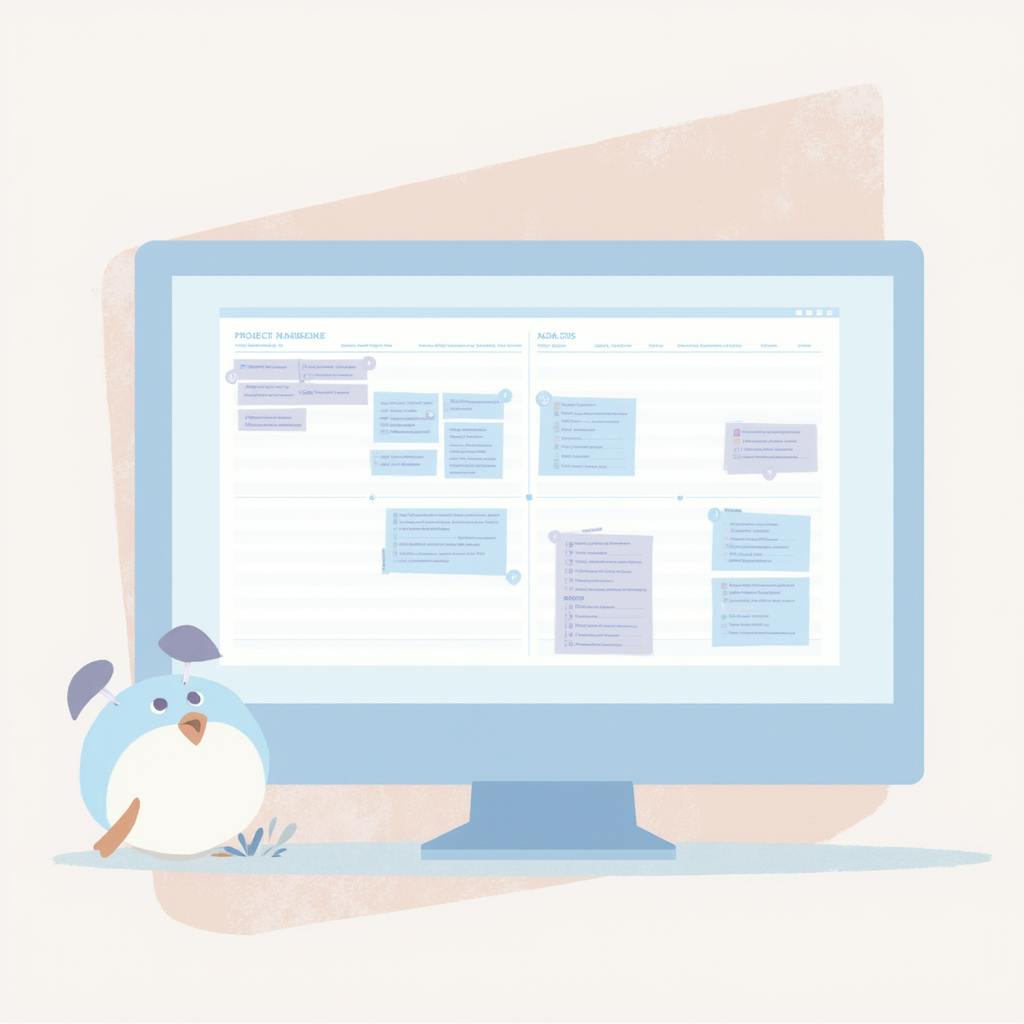In the dynamic world of project management, efficiency is paramount. Project planning templates are essential tools that can help streamline your workflow, saving countless hours. They provide a structured framework to guide your project from conception to completion, ensuring that nothing falls through the cracks. Whether you're tackling a large-scale corporate initiative or a small personal project, having the right template can make all the difference. In this article, we'll explore 10 project planning templates that can boost your workflow efficiency, address common questions, and make project management a breeze.
1. Basic Project Plan Template
Clear and easy to use, this template is perfect for simple projects. It outlines project objectives, tasks, timelines, and resources systematically, allowing you to track progress effortlessly. It’s a hassle-free way to ensure your project stays on track without unnecessary complexity.
2. Gantt Chart Template
A classic in project management, the Gantt chart is your go-to for visualizing project timelines and dependencies. This template provides a graphical representation of your project schedule, helping you manage time efficiently. It's particularly helpful for complex projects that require detailed tracking of interdependent tasks.
3. Risk Management Plan Template
Plan for the unexpected with this focused template. Identify potential risks and develop strategies to mitigate them, ensuring that surprises don't derail your progress. This proactive approach enhances your ability to respond to challenges swiftly and effectively.
4. Excel Project Plan Template
For those who work extensively in Excel, you may wonder, "Does Excel have a project plan template?" The answer is yes. Excel offers customizable templates for project planning that capitalize on its powerful data manipulation capabilities. Leverage Excel's features to handle data-heavy projects more effectively.
5. Agile Sprint Planning Template
Designed for Agile teams, this template helps plan sprints with detailed task assignments and priority settings. It facilitates continuous collaboration and iterative progress, which are hallmarks of Agile methodology, improving team coherence and productivity.

AI made with Dean Jones
6. Budgeting Template
Financial constraints can severely limit project success. This budgeting template helps plan and track project expenses, ensuring financial oversight and preventing overspending. Its intuitive format makes managing project finances straightforward.
7. Marketing Campaign Plan Template
Lead your marketing efforts with this dedicated template, which encompasses strategy, goals, and performance metrics. By using this template, marketing teams can ensure that campaigns are aligned with company objectives and track their impact effectively.
8. Resource Allocation Template
Efficient resource management is crucial for project success. This template helps allocate and track resources, including manpower, equipment, and materials, optimizing their use and minimizing waste.
9. Communication Plan Template
Clear communication can make or break a project. This template ensures that all stakeholders are on the same page by detailing communication strategies, channels, and schedules, thereby improving transparency and collaboration.
10. Post-Project Review Template
After project completion, a thorough review can provide insights for future projects. This template facilitates a structured evaluation, helping teams identify strengths, weaknesses, and areas for improvement.
How Do Project Plan Templates Improve Workflow Efficiency?
Project planning templates are designed to enhance workflow efficiency by providing a clear roadmap, reducing the need for constant decision-making. They help systematically organize tasks, prioritize activities, and allocate resources, which minimizes confusion and redundancy. By using templates, project teams can focus on execution rather than setup, significantly reducing planning time.
How to Create a Project Plan Template
Creating a tailored project plan template involves identifying the core elements necessary for your projects, such as objectives, tasks, timelines, resources, and risks. Customizing a generic template with these components ensures that your template is aligned with specific project needs. Iteratively refine the template based on feedback and project experiences to continually enhance its effectiveness.
FAQ: Project Planning Templates
What are the top 10 project planning templates to streamline my workflow and save hours?
Project planning templates can significantly enhance your efficiency and organization. Here are ten essential templates that can help you streamline your workflow:
- Project Charter Template: Defines the purpose, scope, and stakeholders of a project, setting a solid foundation.
- Work Breakdown Structure (WBS) Template: Breaks down a project into smaller, more manageable components, ensuring clarity in tasks and responsibilities.
- Gantt Chart Template: Provides a visual timeline for project tasks, helping manage time and deadlines more effectively.
- Project Schedule Template: Outlines key milestones and their deadlines, making it easier to track progress and adjust as needed.
- Risk Management Plan Template: Identifies potential risks and outlines mitigation strategies, helping you prepare for uncertainties.
- Communication Plan Template: Details how project information will be disseminated among stakeholders to ensure everyone stays informed.
- Post-Project Review Template: After project completion, a thorough review can provide insights for future projects. This template facilitates a structured evaluation, helping teams identify strengths, weaknesses, and areas for improvement.
How Do Project Plan Templates Improve Workflow Efficiency?
Project planning templates are designed to enhance workflow efficiency by providing a clear roadmap, reducing the need for constant decision-making. They help systematically organize tasks, prioritize activities, and allocate resources, which minimizes confusion and redundancy. By using templates, project teams can focus on execution rather than setup, significantly reducing planning time.
How to Create a Project Plan Template
Creating a tailored project plan template involves identifying the core elements necessary for your projects, such as objectives, tasks, timelines, resources, and risks. Customizing a generic template with these components ensures that your template is aligned with specific project needs. Iteratively refine the template based on feedback and project experiences to continually enhance its effectiveness.
FAQ: Project Planning Templates
How can project planning templates help in saving hours and streamlining workflow?
Project planning templates streamline workflows and save hours in several ways:
- Consistency: Templates provide a standardized format, reducing the need to create documents from scratch and ensuring consistency across projects.
- Efficiency: By using templates, project managers can swiftly input relevant data without worrying about layout and structure, speeding up the documentation process.
- Clarity: Templates help to clearly define roles, tasks, and responsibilities, reducing miscommunication and enhancing team alignment.
- Focus: Ready-to-use templates allow project teams to focus on execution rather than planning logistics, increasing productivity.
- Change Management: Templates make it easier to document and integrate changes, streamlining updates to all stakeholders.

What are the key features to look for in an effective project planning template?
When selecting project planning templates, consider the following key features to ensure effectiveness:
- Customizability: The template should be adaptable to meet the specific needs of your project and organization.
- User-Friendliness: Look for templates that are intuitive and easy to use, without requiring extensive training or technical skills.
- Comprehensiveness: Templates should cover all critical aspects of planning, from task management to budgeting and risk analysis.
- Integration Capability: Ensure the templates can integrate seamlessly with your project management software and other tools.
- Visual Appeal: A well-designed template with visual elements can help in better understanding and communication of the project details.
How do I use project planning templates to improve my project management process?
To enhance your project management process with planning templates, follow these steps:
- Assess Needs: Evaluate your project’s specific requirements and select templates that align with these needs.
- Standardize Processes: Implement standardized templates across all projects to ensure consistency and streamline processes.
- Train Your Team: Ensure team members are familiar with using the templates to maximize their benefits.
- Align with Tools: Integrate your templates with project management tools for real-time updates and seamless workflow.
- Review and Adjust: Regularly review and adapt templates based on project feedback and evolving needs to ensure continuous improvement.
- Document Lessons Learned: Use templates like the Project Closure Report to capture insights and apply these to future projects for ongoing enhancement.
By leveraging these templates, you can achieve more organized, efficient, and effective project management while saving time and reducing the likelihood of errors.
In conclusion, project planning templates serve as invaluable tools for any project manager or business efficiency expert. By leveraging these templates, you can streamline your workflow, improve efficiency, and save countless hours that can be directed towards strategic planning and execution. Whether you opt for an Excel-based template or a specialized tool like a communication or risk management plan, integrating project planning templates into your workflow is a strategic move towards achieving project success.

